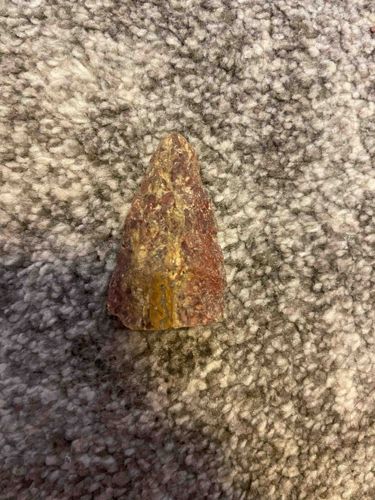
Fossilized Dinosaur Tooth
The item appears to be a fossilized dinosaur tooth, likely from a theropod due to its conical and slightly curved shape. The tooth exhibits a reddish-brown coloration with variations of lighter, yellowish-tan hues, indicating mineral replacement during fossilization. The surface is rough and textured, consistent with excavated fossil material, rather than polished or treated. Longitudinal striations or ridges are faintly visible, which could be growth lines or details of the enamel. The base of the tooth, where it would have connected to the jaw, appears to be relatively flat and broken, suggesting it was broken off from a larger jawbone or root structure. There are no obvious signs of recent damage, repairs, or significant wear beyond what would be expected from geological processes and natural fossilization. The condition suggests it is an authentic fossil, preserved through natural processes. Its relatively small size indicates it could be from a juvenile specimen or a smaller species of theropod. The craftsmanship is natural, as it is a geological specimen, with its quality being determined by preservation and completeness.
AI-Generated Appraisal Disclaimer
Estimated Value
$150-250
Basic Information
Category
Fossil
Appraised On
December 1, 2025
Estimated Value
$150-250
Item Description
The item appears to be a fossilized dinosaur tooth, likely from a theropod due to its conical and slightly curved shape. The tooth exhibits a reddish-brown coloration with variations of lighter, yellowish-tan hues, indicating mineral replacement during fossilization. The surface is rough and textured, consistent with excavated fossil material, rather than polished or treated. Longitudinal striations or ridges are faintly visible, which could be growth lines or details of the enamel. The base of the tooth, where it would have connected to the jaw, appears to be relatively flat and broken, suggesting it was broken off from a larger jawbone or root structure. There are no obvious signs of recent damage, repairs, or significant wear beyond what would be expected from geological processes and natural fossilization. The condition suggests it is an authentic fossil, preserved through natural processes. Its relatively small size indicates it could be from a juvenile specimen or a smaller species of theropod. The craftsmanship is natural, as it is a geological specimen, with its quality being determined by preservation and completeness.
Related Tags
Get Your Items Appraised
Instant estimates of your treasures with AI-powered instant appraisals